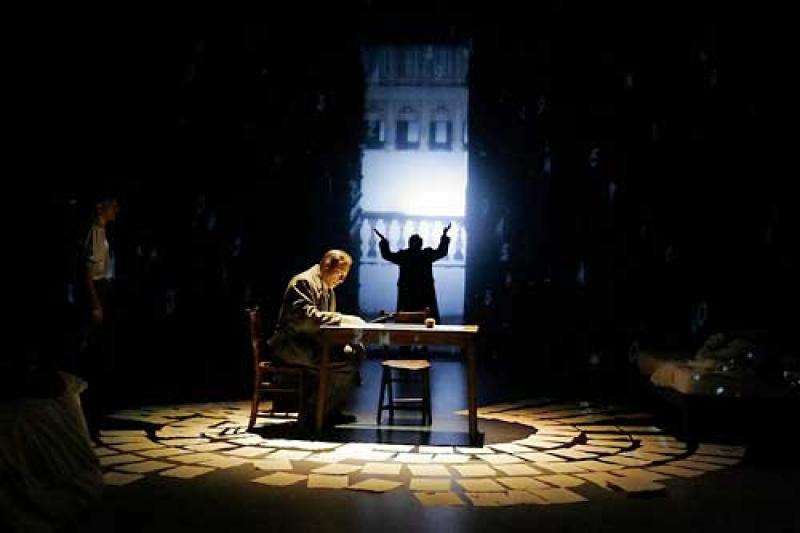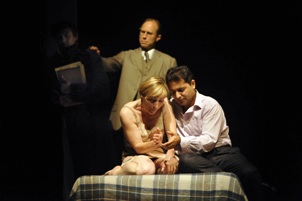A Disappearing Number, Novello Theatre | reviews, news & interviews
A Disappearing Number, Novello Theatre
A Disappearing Number, Novello Theatre
Forget the classroom, this is maths as you've never seen it

“I want to disrupt your sense of logic and show you something really thrilling,” explains a young academic, as her animated scribbling on the whiteboard gains pace and incomprehensible complexity. It’s a promise that Complicite’s A Disappearing Number – now making its third London appearance – has little trouble fulfilling.
Two narratives weave and dance in amongst one other in this extraordinary show. The unlikely kinship between Brahmin mathematics genius Srinivasa Ramanujan – “The most romantic figure in the recent history of mathematics” – and Cambridge don G H Hardy during the First World War is explored alongside the relationship between contemporary maths lecturer Ruth Minnen and her Indian-American husband Al. At the core of it all – filling gaps, forging links – is always maths.
Connections, repetitions and echoes abound, mirroring Hardy’s belief that “a mathematician, like a poet or painter, is a maker of patterns”. Fractured into episodes, the narrative’s fluid transitions and swift temporal leaps are visually enabled by Michael Levine's set whose only constant is change, with even walls and floor proving an unstable quantity. (The latter showcased wittily in a bird's-eye view breakfast scene.) Combining detailed film and image projection with deliberately naïve use of props – the chairs of a lecture room become a taxi in Chennai, an unmade bed transforms into a mountain range – the production’s symbols lure the audience into their own synecdochal substitutions and intuitive leaps, paralleling those of the mathematicians.
 The cast move as one, flowing and shifting between roles and eras in a mixture of dialogue, shadow play, slow-motion movement and even dance. G H Hardy (David Annen) and the young couple, Ruth Minton (Saskia Reeves) and Al Cooper (Firdous Bamji, pictured with Reeves), are the only characters who remain unchanged, a contingent triangle of history, emotion and scepticism respectively. Reeves is particularly moving in her fragile progress from abstraction to human interaction, with a miscarriage scene carrying particularly painful weight and emphasis in her journey.
The cast move as one, flowing and shifting between roles and eras in a mixture of dialogue, shadow play, slow-motion movement and even dance. G H Hardy (David Annen) and the young couple, Ruth Minton (Saskia Reeves) and Al Cooper (Firdous Bamji, pictured with Reeves), are the only characters who remain unchanged, a contingent triangle of history, emotion and scepticism respectively. Reeves is particularly moving in her fragile progress from abstraction to human interaction, with a miscarriage scene carrying particularly painful weight and emphasis in her journey.
It is the humanising, the reframing of mathematics that is the success of this integrated drama. Without ever reducing the complexity of its concepts, maths finds its mirror in human interaction. A romantic relationship is expressed as a converging sequence; numbers – phone numbers, prime numbers, imaginary numbers – take on personal and dramatic significance whose weight can be understood even while the concepts themselves remain unattainably complex.
All this would be elegant and worthy enough, but a single 80-minute act might prove too rich were it not for the tart humour that pervades. “For those who don’t have a working knowledge of string theory I will quote Spike Milligan.” The metatheatrical frame, in which the actors joyously poke their fingers through their theatrical “glasses” and push walls to one side, not only releases the tension of the charged narratives, but also makes a case for the alternative reality of mathematics. “She’s an actress playing a role, but the maths is real – terrifyingly real.”
Music, in an original score by Nitin Sawhney, features throughout, its raga-inspired shapes establishing their own set of patterns. The rhythmic shapes of the tabla player are echoed and transformed into dialogue itself as words give way to voiced rhythmic plosions, the poetry of Ramanujan’s mathematical processes.
There is an elation, a freedom about this incredibly precise drama that is intoxicating. Surrender yourself to its freefall of images and ideas and it repays the trust tenfold, bombarding you with suggestions but rarely imposing conclusions. Above all, A Disappearing Number is a translation of the beauty of numbers and abstraction for the layman, a concept much attempted but rarely successful. Simon McBurney’s is theatre at its most inventive, drawing connections and making relationships in a way that both G H Hardy and Ramanujan would surely have understood.
The future of Arts Journalism
You can stop theartsdesk.com closing!
We urgently need financing to survive. Our fundraising drive has thus far raised £49,000 but we need to reach £100,000 or we will be forced to close. Please contribute here: https://gofund.me/c3f6033d
And if you can forward this information to anyone who might assist, we’d be grateful.

Subscribe to theartsdesk.com
Thank you for continuing to read our work on theartsdesk.com. For unlimited access to every article in its entirety, including our archive of more than 15,000 pieces, we're asking for £5 per month or £40 per year. We feel it's a very good deal, and hope you do too.
To take a subscription now simply click here.
And if you're looking for that extra gift for a friend or family member, why not treat them to a theartsdesk.com gift subscription?
more Theatre
 Ragdoll, Jermyn Street Theatre review - compelling and emotionally truthful
Katherine Moar returns with a Patty Hearst-inspired follow up to her debut hit 'Farm Hall'
Ragdoll, Jermyn Street Theatre review - compelling and emotionally truthful
Katherine Moar returns with a Patty Hearst-inspired follow up to her debut hit 'Farm Hall'
 Troilus and Cressida, Globe Theatre review - a 'problem play' with added problems
Raucous and carnivalesque, but also ugly and incomprehensible
Troilus and Cressida, Globe Theatre review - a 'problem play' with added problems
Raucous and carnivalesque, but also ugly and incomprehensible
 Clarkston, Trafalgar Theatre review - two lads on a road to nowhere
Netflix star, Joe Locke, is the selling point of a production that needs one
Clarkston, Trafalgar Theatre review - two lads on a road to nowhere
Netflix star, Joe Locke, is the selling point of a production that needs one
 Ghost Stories, Peacock Theatre review - spirited staging but short on scares
Impressive spectacle saves an ageing show in an unsuitable venue
Ghost Stories, Peacock Theatre review - spirited staging but short on scares
Impressive spectacle saves an ageing show in an unsuitable venue
 Hamlet, National Theatre review - turning tragedy to comedy is no joke
Hiran Abeyeskera’s childlike prince falls flat in a mixed production
Hamlet, National Theatre review - turning tragedy to comedy is no joke
Hiran Abeyeskera’s childlike prince falls flat in a mixed production
 Rohtko, Barbican review - postmodern meditation on fake and authentic art is less than the sum of its parts
Łukasz Twarkowski's production dazzles without illuminating
Rohtko, Barbican review - postmodern meditation on fake and authentic art is less than the sum of its parts
Łukasz Twarkowski's production dazzles without illuminating
 Lee, Park Theatre review - Lee Krasner looks back on her life as an artist
Informative and interesting, the play's format limits its potential
Lee, Park Theatre review - Lee Krasner looks back on her life as an artist
Informative and interesting, the play's format limits its potential
 Measure for Measure, RSC, Stratford review - 'problem play' has no problem with relevance
Shakespeare, in this adaptation, is at his most perceptive
Measure for Measure, RSC, Stratford review - 'problem play' has no problem with relevance
Shakespeare, in this adaptation, is at his most perceptive
 The Importance of Being Earnest, Noël Coward Theatre review - dazzling and delightful queer fest
West End transfer of National Theatre hit stars Stephen Fry and Olly Alexander
The Importance of Being Earnest, Noël Coward Theatre review - dazzling and delightful queer fest
West End transfer of National Theatre hit stars Stephen Fry and Olly Alexander
 Get Down Tonight, Charing Cross Theatre review - glitz and hits from the 70s
If you love the songs of KC and the Sunshine Band, Please Do Go!
Get Down Tonight, Charing Cross Theatre review - glitz and hits from the 70s
If you love the songs of KC and the Sunshine Band, Please Do Go!
 Punch, Apollo Theatre review - powerful play about the strength of redemption
James Graham's play transfixes the audience at every stage
Punch, Apollo Theatre review - powerful play about the strength of redemption
James Graham's play transfixes the audience at every stage
 The Billionaire Inside Your Head, Hampstead Theatre review - a map of a man with OCD
Will Lord's promising debut burdens a fine cast with too much dialogue
The Billionaire Inside Your Head, Hampstead Theatre review - a map of a man with OCD
Will Lord's promising debut burdens a fine cast with too much dialogue

Add comment